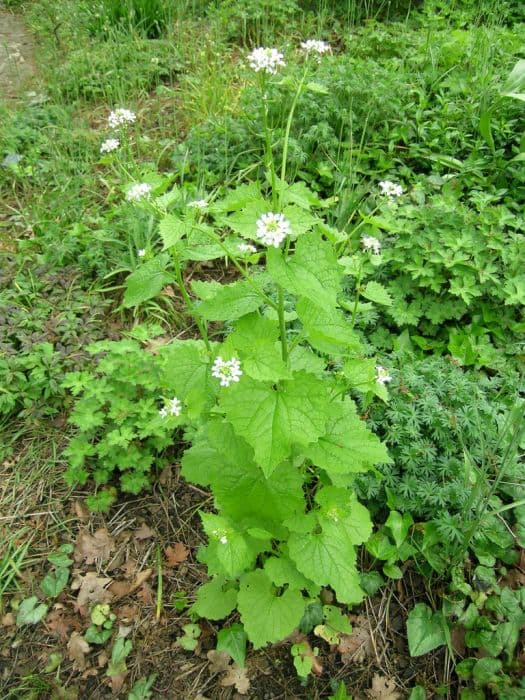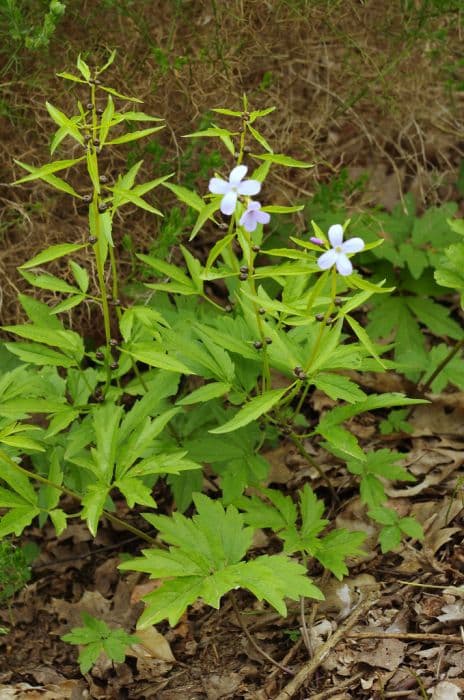Wallflower Erysimum cheiri 'Persian Carpet' (mixed)

ABOUT
The Persian Carpet Wallflower is known for its vibrant and richly colored flowers, which make it a popular choice in gardens for adding a splash of color. The plant typically produces a dense cluster of foliage, with leaves that are lance-shaped, slightly toothed, and often a grayish-green color that provides a nice backdrop to the brilliant flowers. The flowers themselves are the main attraction. They come in a mix of warm colors, including shades of yellow, orange, red, pink, and purple. Each blossom has a four-petaled structure that can sometimes appear as if they are miniature butterflies perched amongst the foliage. Persian Carpet Wallflower flowers have a delightful fragrance that can be especially strong on warm, sunny days, filling the air around the plant with a sweet and pleasant aroma. Owing to this pleasing scent, they are often planted in areas where people can enjoy it, such as near pathways, windows, or seating areas. Throughout their blooming season, these wallflowers provide a continuous display of color that can breathe life into a garden space. Their flowers are typically arranged in clusters at the top of the stems, giving the impression of a colorful carpet draped over the green leaves, which contributes to the picturesque and decorative appearance for which this plant is cherished by gardeners and flower enthusiasts alike.
About this plant
 Names
NamesFamily
Brassicaceae
Synonyms
Wallflower, English Wallflower, Gillyflower
Common names
Cheiranthus cheiri, Erysimum ochroleucum, Syrenia cheiri, Cheiranthus incanus, Cheiranthus mutabilis, Cheiranthus erysimoides.
 Toxicity
ToxicityTo humans
Wallflower, typically Erysimum cheiri, is not commonly known as highly toxic to humans. However, as with many plants, it may cause mild discomfort if ingested. Reactions can vary from person to person. Symptoms could include nausea, vomiting, and diarrhea if consumed in large quantities. It is always advisable not to eat ornamental plants due to their potential toxicity and to keep them out of reach of children who might ingest them out of curiosity. Contact your local poison control center or seek medical attention if you suspect poisoning from any plant.
To pets
Wallflower is not commonly listed as highly toxic to pets. However, it is generally recommended to prevent pets from eating ornamental plants as they could potentially cause gastrointestinal upset, including symptoms like vomiting and diarrhea. As individual pets may have different sensitivities, it's best to monitor your pet's health and seek veterinary attention if you notice signs of illness after ingestion of any part of the plant. Always provide plenty of pet-safe greens to discourage your pets from nibbling on potentially harmful plants.
 Characteristics
CharacteristicsLife cycle
Biennials
Foliage type
Evergreen
Color of leaves
Green
Flower color
Mixed
Height
1 foot 8 inches (50 cm)
Spread
1 foot (30 cm)
Plant type
Herb
Hardiness zones
7
Native area
Mediterranean
Benefits
 General Benefits
General Benefits- Ornamental Value: Erysimum cheiri 'Persian Carpet' is known for its vibrant, colorful flowers that can enhance the aesthetic appeal of gardens and landscapes.
- Attracts Pollinators: The plant’s blooms attract beneficial insects such as butterflies and bees, which are essential for pollination.
- Seasonal Interest: This variety typically flowers in late winter to spring, providing color when many other plants are dormant.
- Drought Tolerance: Once established, Wallflower is relatively drought-tolerant, making it suitable for xeriscaping and low-water gardens.
- Compact Growth: Wallflower's compact growth habit makes it suitable for smaller spaces, borders, and containers.
- Easy Propagation: Wallflower can be easily propagated from seed or cuttings, facilitating garden expansion or sharing with fellow gardeners.
- Cold Hardy: This plant can withstand frosts and colder temperatures, making it a robust addition to a variety of climate gardens.
- Versatile Planting: Wallflower is versatile and can be used in rock gardens, alpine settings, or as part of a perennial border.
- Long Blooming Period: 'Persian Carpet' has a relatively long blooming period which provides long-lasting color in the landscape.
 Medical Properties
Medical PropertiesThis plant is not used for medical purposes.
 Air-purifying Qualities
Air-purifying QualitiesThis plant is not specifically known for air purifying qualities.
 Other Uses
Other Uses- Wallaby Wallflower 'Persian Carpet' can be utilized in container gardens to add vibrant color and vertical interest due to its clustered growth habit.
- In creative arts and crafts, the dried flowers of Wallflower 'Persian Carpet' can be used for making natural dyes, offering a range of warm tones.
- This plant can play a role in companion planting in vegetable gardens, potentially deterring certain pests with its strong scent.
- Wallflower 'Persian Carpet' can be used as a living mulch, suppressing weeds and maintaining soil moisture when planted densely.
- The tall and showy stalks of Wallflower 'Persian Carpet' are ideal for adding structural interest in mixed floral arrangements.
- When planted along walkways, the fragrance of Wallflower 'Persian Carpet' can create a pleasant, aromatic experience for passersby.
- The flowers of Wallflower 'Persian Carpet' can be pressed and included in personalized stationery or bookmarks as a decorative element.
- Cultivating Wallflower 'Persian Carpet' in a sensory garden can provide a tactile experience due to its varied leaf textures.
- Wallflower 'Persian Carpet' can serve as an educational tool in schools or community gardens, teaching about plant life cycles and pollinators.
- In photography, the rich colors and patterns of Wallflower 'Persian Carpet' can serve as an inspiring subject for macro photography enthusiasts.
Interesting Facts
 Feng Shui
Feng ShuiWallflower is not used in Feng Shui practice.
 Zodiac Sign Compitability
Zodiac Sign CompitabilityWallflower is not used in astrology practice.
 Plant Symbolism
Plant Symbolism- Survival and Resilience: As a hardy perennial, Erysimum cheiri, commonly known as Wallflower, often symbolizes survival and the ability to withstand difficult conditions.
- Faithfulness in Adversity: Wallflowers stay put in one place and thrive against the odds, representing fidelity and steadfastness, even in challenging situations.
- Humility: The Wallflower's tendency to grow in less conspicuous places and its subdued beauty can symbolize modesty and humility.
- Lasting Beauty: With its long-lasting blooms, the Wallflower signifies enduring beauty and the persistence of affection over time.
- Adoration: This plant also stands for feelings of adoration, stemming from its historical association with being "pinned to the wall" at dances, overlooked until a suitor shows it attention.
 Water
WaterWallflowers need to be watered deeply but infrequently, allowing the soil to dry out slightly between watering sessions. A good estimate is to water every 7 to 10 days, supplying about 1 inch of water each time, which equates to approximately 0.5 to 1 gallons for a medium-sized plant. Adjust the amount based on weather conditions; more water may be needed during hot, dry periods and less during cool, damp weather. Ensure that the soil has good drainage to prevent waterlogging, which can cause root rot.
 Light
LightWallflowers thrive in full sunlight, meaning they prefer a spot that receives at least 6 hours of direct sunlight per day. However, in extremely hot climates, they can benefit from light afternoon shade to protect them from the intense heat of the sun. The plant will produce more vibrant blooms when it has ample light, so positioning it in a sunny location is key for optimal growth and flowering.
 Temperature
TemperatureWallflowers prefer a temperate range and can generally tolerate temperatures down to about 20 degrees Fahrenheit. Their ideal growing conditions lie within the range of 55 to 75 degrees Fahrenheit. They can survive short periods of lower temperatures, but prolonged exposure to cold below the minimum can damage or kill the plant.
 Pruning
PruningPruning wallflowers promotes bushier growth and more prolific blooming. Deadhead spent flowers regularly to encourage new ones. Cut back the plants by about one-third after the main blooming period, usually in late spring or early summer, to maintain their shape and encourage a second flush of flowers. Pruning is typically done annually or after blooming cycles.
 Cleaning
CleaningAs needed
 Soil
SoilWallflower 'Persian Carpet' prefers well-drained, loamy soil enriched with organic matter. The ideal soil pH should range between 6.0 and 7.0 for optimal growth.
 Repotting
RepottingWallflower 'Persian Carpet' generally does not require frequent repotting and can be repotted every two to three years or when it outgrows its current container.
 Humidity & Misting
Humidity & MistingWallflower 'Persian Carpet' tolerates typical outdoor humidity levels well and does not have specific humidity requirements.
 Suitable locations
Suitable locationsIndoor
Provide bright light and well-drained soil for indoor Wallflower 'Persian Carpet'.
Outdoor
Plant in full sun, well-draining soil, and space 12 inches apart.
Hardiness zone
Wallflower 'Persian Carpet' is suitable for USDA zones 7-9.
 Life cycle
Life cycleErysimum cheiri 'Persian Carpet', commonly known as Wallflower, starts its life cycle as a seed which, when sown, germinates usually within two weeks under optimal conditions. Once germinated, the seedling goes through vegetative growth, developing a rosette of leaves at the ground level before entering the next stage. As the plant matures, it begins to elongate and form a flowering stalk during spring, which is characterized by a burst of colorful blossoms that may vary in shade depending on the mix. Following pollination by insects, the Wallflower sets seed in elongated pods that dry and split open, releasing the seeds for dispersal. The Wallflower is often biennial, meaning it may complete its life cycle, from germination to natural seed dispersal, in two years; however, it can sometimes behave as a short-lived perennial, surviving and flowering for several seasons under the right conditions. After seed dispersal, the parent plant typically dies, having ensured the continuation of its species through the next generation of seeds.
 Propogation
PropogationPropogation time
Spring to Summer
Propogation: The most popular method of propagation for Wallflower 'Persian Carpet' (mixed), scientifically known as Erysimum cheiri 'Persian Carpet', is by seed. Wallflowers are typically sown in late spring or early summer, but they can also be sown in fall in climates with mild winters. The seeds are spread over the surface of well-drained soil and lightly pressed in or covered with a thin layer of soil no more than 1/8 inch thick. It's crucial to keep the soil moist until germination, which usually occurs within 14 to 21 days. Once the seedlings have developed true leaves, they can be thinned out to prevent overcrowding and provide each plant enough space to grow. Transplanting should be done to their final positions either in the fall or the following spring.








